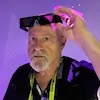
Welcome back to our weekly roundup of happenings from XR and AI realms. Let’s dive in…
The Lede
The UK High Court ruled against Getty in its case against Stability AI, rejecting the argument that training an AI model constitutes copyright infringement. The judge held that Stable Diffusion does not store or reproduce copyrighted images, aligning with James Cameron’s public stance that AI models “learn” rather than copy. Only a narrow watermark issue remains. The ruling accelerates a market shift already underway: major rights holders are moving from litigation to licensing, as shown by Universal Music’s settlement and partnership with Udio. The strategic takeaway: companies should adopt licensed, indemnified AI stacks now, instead of waiting for definitive legal precedent.
Feeling Spatial
VITURE is partnering with NVIDIA to advance XR + AI. Nvidia’s XR AI platform is designed to integrate headsets and smart glasses with data-center and edge AI. VITURE display glasses are driving immersive workflows where AI agents perceive, understand, and act inside spatial environments. VITURE’s own commercially available consumer display glasses deliver features such as AI-powered “Immersive 3D” that converts 2D content into depth-rich AR experiences, and the voice assistant “Vizard” for XR usage. VITURE CEO David Liang described the collaboration as a transition from hardware cosmetics to data-and-agent-driven XR, where the glasses become portals to intelligent, context-aware systems.
The National Institutes of Health has awarded nearly $4.5 million to Rendever for its “MultiBrush” VR studio, aimed at creating positive virtual-reality experiences for older adults. Rendever launched Multi-Brush soon after Google put Tilt Brush on Github as an open source platform, adding features that the original did not have. Rendever is no stranger to elder tech. It has been working with AARP on Metaverse projects for a decade.
Trace, a no-code AR authoring platform built by former Magic Leap employees, has officially launched with the pitch that it is the “Canva of AR.” The timing is deliberate: Adobe Aero shuts down today and Meta Spark AR ended in January, leaving creators without a tool. Trace lets users build and publish high-fidelity, location-based AR scenes across phones, headsets, and glasses, and is already used by ESPN, T-Mobile, Qualcomm, Telefónica, Lenovo, and Deutsche Telekom. The company is offering three free months to displaced Aero and Spark users. The iOS app is free, with a $20 monthly premium tier and a web studio for asset import.
The AI Desk
Google Maps is adding Gemini AI to make apps conversational, not command-based. Instead of tapping menus, drivers will be able to ask natural questions like “find vegan lunch on my route,” “where can I park near the venue,” or “add this to my calendar.” Google says the answers will be grounded in real maps and place data to avoid hallucinations. The rollout starts on Android and iOS, with in-car systems to follow. The move pushes Maps beyond turn-by-turn navigation toward an AI copilot for local search, errands, and trip planning.
AI data centers are driving a surge in electricity demand that consumers, not tech companies, are effectively paying for. A new analysis of 83 US AI facilities shows that in states with smaller power grids, AI already consumes a staggering share of total electricity. Indiana is the most extreme case: three AI clusters now use 47 percent of all power generated in the state. Wisconsin has one site burning 25 percent of statewide electricity. Even Texas, with the nation’s largest grid, sees 15 percent of its power diverted to 17 AI hubs. Meanwhile, ChatGPT alone draws enough energy each day to power 33,000 US homes. Profits remain private, but the higher utility bills and grid stress are socialized across ratepayers.
Memories.ai introduced its second-generation Large Visual Memory Model, designed to run fully on-device through a new partnership with Qualcomm. Beginning in 2026, Snapdragon-powered phones, cameras, and wearables will be able to index video locally, turning raw footage into a searchable visual memory layer rather than relying on cloud processing. The model structures video into compressed, queryable frames so users can ask natural-language questions or use an image prompt to jump to a specific moment. Qualcomm says on-device processing reduces latency, cuts cloud cost, and keeps data private. Target use cases include consumer “AI albums,” smart glasses recall, real-time security analysis, and robotics.
Freya raised $3.5 million in a seed round led by Y Combinator. Backers include Rebel Fund, 212 VC, N1 Tech, and BD Partners. Founded by former University of Pennsylvania classmates Tunga Bayrak and Tomáš Nepala, the company builds humanlike voice AI agents that automate complex inbound and outbound phone calls for banks, insurers, and fintechs. Freya’s platform delivers natural speech, strict compliance, and 24/7 availability, handling thousands of customer conversations daily. As enterprises move to AI-driven support, Freya is positioning itself as the core voice infrastructure for global customer operations.
AI Creative Corner
Secret Level reunited with Coca-Cola for a second AI-powered holiday campaign, expanding last year’s viral “Holidays Are Coming” work into a fully animated global film. The studio built the project from scratch using advanced generative tools that now enable cinematic-quality animation and emotional character performance. Secret Level founding partner Jason Zada directed a team of twenty-five people to produce a high-quality, emotionally resonant short worthy of a venerated global band that would have once cost millions. If you can’t tell the difference, there is no difference.
Kavan the Kid sent this dramatic short made exclusively with AI tools, “The Last Lost Boy.” If you’ve ever wondered what happened in Neverland after Wendy and the gang left for the nursery, this short will show you one possible answer. Kavan is one of my favorites among the hundreds of Hollywood professionals who have unprecedented access to the means of production, which would otherwise have cost millions. There are many filmmakers working in AI under pseudonyms to avoid being labelled by Hollywood’s misguided anti-AI mind virus.
Dusan Simic sent this video for a new AI band, Budallaz. It takes place in Coon City, a shattered post-apocalyptic landscape inhabited by anthropomorphic animals.
Spatial Audio
For more spatial commentary & insights, check out the AI/XR Podcast, hosted by the author of this column, Charlie Fink, and Ted Schilowitz, former studio executive and futurist for Paramount and Fox, and Rony Abovitz, founder of Magic Leap. This week’s guest is AWE Hall-of-Famer Tom Furness, founder of U. Washington’s HIT Lab. You can find it on podcasting platforms Spotify, iTunes, and YouTube.
 Charlie Fink is an author and futurist focused on spatial computing. See his books here. Spatial Beats contains insights and inputs from Fink’s collaborators, including Paramount Pictures futurist Ted Shilowitz.
Charlie Fink is an author and futurist focused on spatial computing. See his books here. Spatial Beats contains insights and inputs from Fink’s collaborators, including Paramount Pictures futurist Ted Shilowitz.





